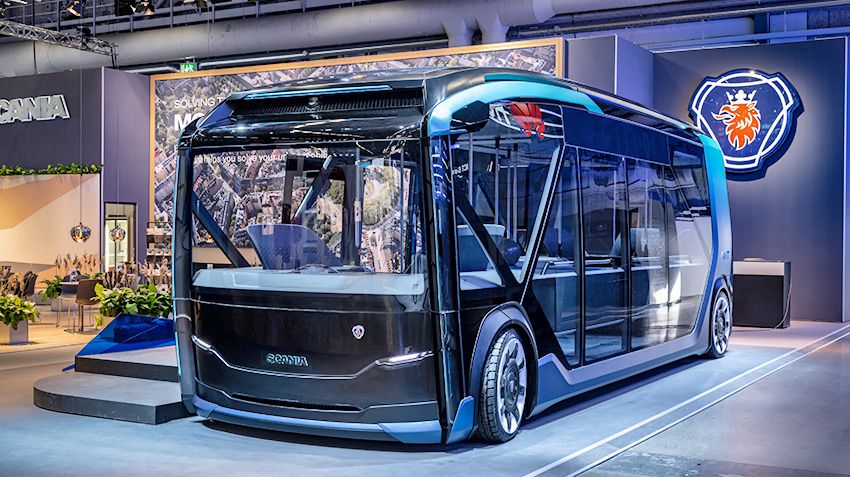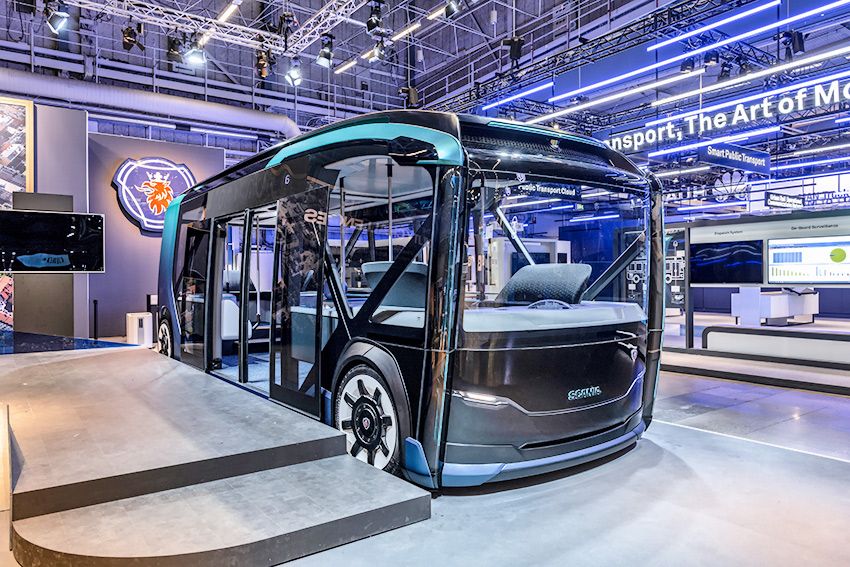Shuttle Scania NXT sample 2030 showed in Stockholm

10 June 2019
Scania believes that in 2030, passengers can carry mixed goods and garbage
Company Scania AB, presented his vision of driverless urban transport on electricity in 2030. In her opinion in the near future not only transportation of goods but also the transport of people and even garbage collection will take place using one and the same electrolysi, i.e. unmanned module. However, according to developers from Scania already at new technological level. Scania NXT concept, working prototype which is in the development stage, shows a new level of philosophy of modular development directions of the company, representing a transport platform on which you can install various specialized modules. However, even the presence of the auxiliary driver is not provided. In Scania believe that the typical daily operating cycle begins with the carriage of passengers to work, followed by a daytime delivery of goods, and then the chassis will switch back to passenger mode for the return trip home. At night (morning, identity), time noiseless transport module may collect debris. A kind of further development of the wheeled version of Thunderbird 2. The difference is that NXT is equipped with a detachable unmanned modules drive the front and rear axles, which be assigned functions, usually implemented power plant, transmission, the chassis and driver of a conventional truck. Food, of course, be electrical from batteries located under the floor of the modules. Accordingly, universal power modules at the front and rear the NXT can be installed under passenger, cargo, or musorovozy body modules.

Bus module (Shuttle) this concept vehicle will be presented from 10 to 12 June 2019 in Stockholm at the summit of public transport UITP Public Transport Global Summit.
The concept of NXT is a 8-meter legalnotice modules installed with them (judging by the teaser) is compact enough electromotive blocks front and rear axles. When full weight NXT less than 8,000 kg, it is expected that its range of travel will reach 245 km using cylindrical batteries placed under the floor for optimum space utilization and rational distribution of weight. However, Scania hopes that the battery technology in the next decade, can occur a real revolution.

Chairman of the Board of Scania and member of the Board of TRATON AG Henrik Henriksson said: "the NXT model of the future of urban transport. It still needs some work, but now the engineers at Scania were able to show what can be achieved when creating the electric Autonomous vehicle. The NXT brick will be ready by 2030, but some of the latest technology that we use in its construction are already readily available".
Project Manager NXT Robert Ciudin said: "When you are creating the innovative model applied basic design principles of the Scania – flexible configuration designs and modular units".
According to experts Scania, radical renewal of vehicles is necessary to improve the ecosystem, and, in the short term, the emphasis is made exactly on the technological and infrastructural innovations in the field of electric and Autonomous vehicles. Their use is advantageous both from the economic point of view (yet nowhere in the world has not been proven – ed.) reduces harmful effects on the environment (excluding all costs in the production and disposal of all components according to the production and consumption of electricity – ed.).
Henrik Henriksson says: "Now the traffic in the cities is not optimal, and Scania can't re-create the transport system. However, with NXT we can promote positive changes – optimization of traffic flows to improve the environmental situation in cities and to improve safety."
Scania seeks to show that public transport, originally designed for sharing to a whole new level that is made possible by the development of automation.
For example, Robert Sudin says: "the Gradual continuous improvement is the hallmark of Scania, and today we are taking a big step towards the future. So, using a new conceptual model, we get invaluable evidence for further development of Autonomous electric vehicles".
PS That's what you want me to do, but I have no idea how you can actually in everyday life (not on drawing pictures of their future) to use the same chassis for the transport of waste and passengers, and even goods. Why should junk, the module will be totally sterile even if you wash it daily? Yes, this, supposedly, will help separate waste collection (which, sorry, in selected countries of West even clips from used tea bags make to remove!), but in most of the less environmentally advanced countries in the world picture, to put it mildly, "a bit different". However, even in this case, indestructible residual smell of so-called "biological waste" it is able to discourage any desire to ride in such a vehicle to work, etc. Yes, there are a number of foods (e.g., dairy, bread, etc., etc.) is impossible without compromising the quality and safety of transport in the presence of other selenomonas products, such as household chemicals! Say – so because the modules are different, because replacement! However, the laws of gravity, when all the liquid flows down, and the solids fall well the same to the center of the Earth, as well as physics of gases, which says that all smells rise up that does not change. Yet something wasn't even the idea of interchangeable modular medical – when worn chassis module with medical equipment is relocated to a new. I'm not talking about a variety of sanitary-hygienic norms, which differ very conservatism and inertia. And then, sorry, stinking musorovozy motor-wheel trolley will be used under the passenger or cargo modules for the products. Surprisingly, that is not suggested to use sanitary modules! In my opinion, this is the most notorious "modularity" as the next panacea for dramatically reducing the traffic on roads is already beginning to "lose the coast". Normal people seem to just have to turn one's stomach the idea that carry them mixed with garbage...
P. P. S. I can understand if the night musorovozy module used for street utility work – watering/street cleaning, repair, lighting, etc., purposes, landscaping, transportation are not critical to the smell goods, etc. Probably still the idea of combining the transport of waste, passengers and food – is that too radical..
|
|
|
Element was not found.








